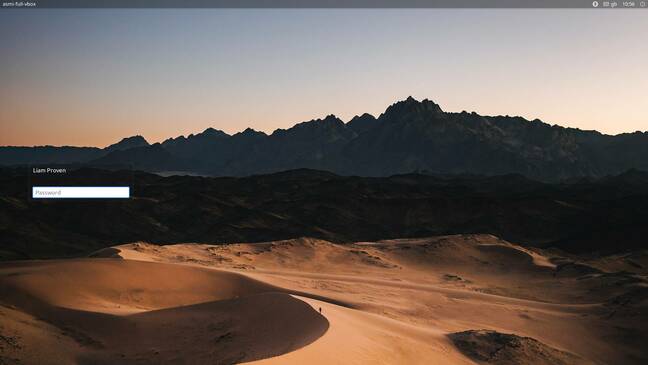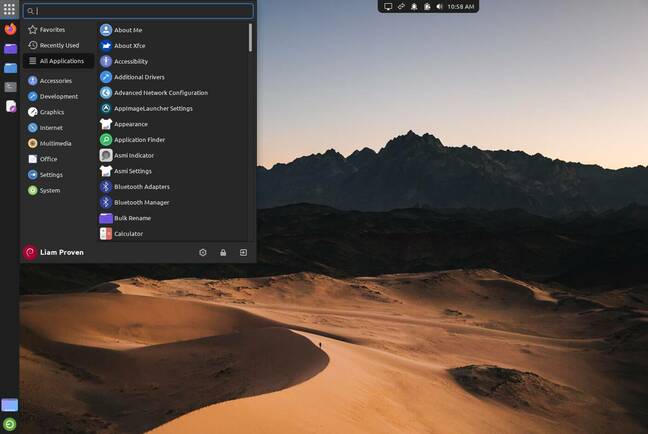The latest version of Teejeetech’s take on Ubuntu offers what many users wish Canonical did – natively packaged Firefox and the choice of whether to use Snap, Flatpak, or neither.
Asmi 24.04 is the new LTS release, based on the newly released Ubuntu 24.04 “Noble Numbat.” It offers a selection of interesting refinements to Canonical’s underlying OS, many of which we suspect will be crowd-pleasers.
Asmi is the successor to Zinc Linux, which we looked at in late 2022. Developer Tony George renamed it to avoid confusion with another Debian distro that chose the same name.
Rather than stock Ubuntu with the GNOME desktop, it’s fairer to compare Asmi to the nearly Snap-free Xubuntu 24.04. Like Xubuntu, it comes with Xfce, and like Xubuntu “Noble,” it offers two separate downloads. As well as a full edition, both also give you the choice of a minimal edition with few installed apps.

Asmi’s login screen. We like the wallpaper, evoking the loneliness of going without two bloated package formats, perhaps – click to enlarge
The key difference is that Asmi Mini comes with a web browser, while Xubuntu’s minimal version has no web browser at all. Not having one has a benefit. It means that Xubuntu Minimal comes with no Snap packages installed, which makes it very easy to remove Snap support altogether. However, adding a native Debian-packaged browser does require copying and typing in some very long complicated commands from another internet-connected device.
By contrast, both minimal and full versions of Asmi offer a choice of browsers. In the live session, the full edition has Firefox, while the Mini edition offers a simple browser called just “Web.” The package name is minnie, and as far as we can tell it’s an in-house tool that puts a Gtk3 wrapper around WebKit2. It has no tabs, no menus, and few buttons – back, next, reload, and one to toggle dark mode – but it does the job. Once installed, both editions offer the same post-install choices of browsers and other add-ons.
Both flavors of Asmi have a handy Asmi Settings app that walks you through the post-installation first run. It offers the choice of light or dark themes – which notably have slightly thicker, easier-to-hit window borders than plain Xfce – and then proposes several layouts for the Xfce desktop: Asmi’s own all-in-one vertical panel on the left, or Windows-like or Ubuntu-like layouts, or a simpler dock on the left and an auto-hiding floating status panel at the top. Then it will install any additional drivers your hardware needs. Then it offers to install your choice of web browsers: Firefox, Chrome, Microsoft Edge, Vivaldi, or any combination thereof. Finally, it offers to install WINE, the Microsoft-free TrueType font collection, and the Steam games store client.
Previous versions of the Asmi distro offered an edition with the GNOME desktop, but not any more. Multiple other Ubuntu remixes offer their own versions of the JavaScript-based GNOME shell anyway. Now Asmi offers only Xfce, but this strikes us as a sensible choice. It’s lightweight but very customizable. Asmi preloads the Docklike Taskbar plug-in, for the big, friendly taskbar buttons Windows has offered since Vista. One extra that isn’t present is the option of a global menu bar in the top panel. Since Teejeetech offered the original Unity remix, U-Mix, we asked developer Tony George why not. He told us:
Even so, compared to all the other desktops out there, we feel that Xfce wins on features, size, and performance. It offers more customization than LXQt in hardly any more RAM; it’s not only smaller than MATE, it’s also in active development; and it’s considerably lighter-weight and more responsive than KDE or Cinnamon.
Asmi has more than just these conveniences and cosmetic tweaks. It both disables Canonical’s irksome ads for Ubuntu Pro and preloads the handy Nala package manager. It also preloads the Atuin shell history tool, which securely syncs your command history between your Linux machines as well as offering improved searching. We’ve been meaning to try this ever since seeing developer Ellie Huxtable‘s FOSDEM talk. Another nifty Rust shell enhancement included is the Starship prompt. Other useful tools pre-installed include Synaptic and the GParted graphical partitioner.

Asmi’s clever hybrid layout, with a clean dock and a floating, auto-hiding system tray – click to enlarge
Other minor modifications fix other Ubuntu “paper cuts.” If you run Asmi in a hypervisor, it tries to set a nice big 1080p window size, then displays the display settings. Asmi permits the user to install Python packages more freely, and relaxes the security on Electron apps that prevents some of them working in Ubuntu Noble. It includes the official Linux 7-Zip compression app rather than the long-dormant p7zip. If you choose Firefox, it installs the DEB version directly from Mozilla. We miss the days when Ubuntu itself displayed such attention to detail.
Asmi uses the same Calamares cross-platform installer seen in Lubuntu and Kubuntu. Its default file system layout is rather different from Ubuntu’s. The standard offering is a Btrfs file system, with compression enabled but no snapshot support, plus a separate /data volume. The installer offers a choice of swap configurations, which is another small win, and it even has an attractive graphical GRUB menu. Aside from .deb packaged web browsers, it only draws packages from official Ubuntu repos, which it stores in /etc/apt/sources.list like older Debian-family distros.

Asmi Mini’s Windows-style layout, with Settings and the handy little Asmi Indicator. Who needs Cinnamon? – click to enlarge
We like Asmi, as we liked Zinc before it. One sad omission from this release in earlier versions is the deb-get package assistant, which makes it very easy to install native versions of many popular third-party apps from Zoom to Slack. For now, Teejeetech has no choice. Sadly, deb-get doesn’t support the Noble release of Ubuntu yet. We suspect it may yet reappear.
We tried Asmi 24.04 on our battered ThinkPad X220, and it installed perfectly and ran very quickly and smoothly. As far as compatibility goes, it’s Ubuntu. Any machine that can run Xubuntu well will run Asmi well too. We might not choose exactly the same set of tweaks and enhancements, but we can’t fault its attention to detail.
The full edition takes about 4.8 GB of disk, while the Mini edition takes 3 GB. The Full edition offers both Xfce’s own Thunar file manager and for power users the Nemo file manager from Cinnamon, as well as an assortment of additional accessories.
If you know enough about Linux to have opinions about packaging systems, and you want Ubuntu without Snap, this is the easiest way to get there. Linux Lite is also free of both Snap and Flatpak, and we plan to look at version 7 as soon as it’s released. However, like Linux Mint, it’s mainly aimed at new migrants from Windows. Mint is a solid beginners’ distro, but in this vulture’s humble opinion, Flatpak is not really preferable to Snap in any meaningful way. Asmi offers the most pragmatic desktop, but lets you choose packaging tools and extensions in ways that neither Mint nor Linux Lite can match. ®












